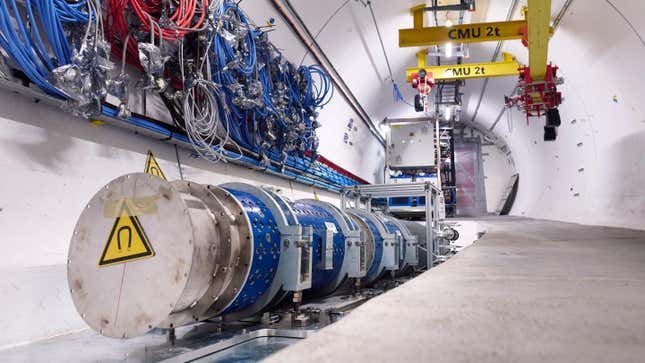
Last week, a team of physicists working in CERN’s Large Hadron Collider announced the facility’s first detection of neutrinos, which are some of the smallest, most weakly interacting particles yet proven to exist.
Neutrinos are basically omnipresent in the universe, but only in the right conditions do they interact with ordinary matter. Trillions of neutrinos are passing through your body as you read this sentence. But to actually “see” the particles, physicists have to build massive detectors in extremely isolated conditions.
Neutrino detectors have been buried in mile-deep ice or submerged in the deepest lake in the world, for example. But the recent detection—published in Physical Review D last week—flips that script, as it is the first one to come out of a collider.
“Prior to this project, no sign of neutrinos has ever been seen at a particle collider,” said study co-author Jonathan Feng, a physicist at the University of California-Irvine and a co-leader of the collaboration that managed the experiment, in a press release. “This significant breakthrough is a step toward developing a deeper understanding of these elusive particles and the role they play in the universe.”
The particles were detected by a pilot run of an emulsion detector called FASER, a particle physics experiment at the Large Hadron Collider. Emulsion detectors are a way of looking for super-small particles, like the unknown stuff that constitutes dark matter.
“It turns out that the most energetic neutrinos are produced along the beamline,” Feng told Gizmodo in an email. “These neutrinos are the most likely to interact, and so by placing FASER along the beamline, we were able to catch a few of them, even though FASER is a very small detector.”
The FASER pilot detector was made of alternating lead and tungsten plates (101 and 120 of them, respectively), each containing a corresponding number of emulsion films. Neutrinos produced by the reactions in the Large Hadron Collider smash into the heavy metal nuclei in FASER, leaving marks of their presence on the emulsion layers.

Feng said that the future of the experiment is “definitely optimistic” and that FASER’s success shows the team is on the right track. “In many scientific areas, the first experiment detects a few particles, a second experiment detects a few more, and a third detects enough to do precise measurements,” Feng said. “What this result means is that we expect to pass through all three stages in rapid succession in the next few years. By 2024, we should have detected 10,000 neutrinos at the LHC, and it will be exciting to see what they tell us.”
FASER is a precursor to FASERnu, a planned experiment that will be more reactive and discerning than the current pilot. Besides studying the interactions of high-energy neutrinos, FASERnu is also designed to look for new weakly coupled elementary particles and dark matter candidates like dark photons.
“Given the power of our new detector and its prime location at CERN, we expect to be able to record more than 10,000 neutrino interactions in the next run of the LHC, beginning in 2022,” said David Casper, also a physicist at UC-Irvine, a co-lead of FASER and a co-author of the new paper, in the same release. “We will detect the highest-energy neutrinos that have ever been produced from a human-made source.”
FASERnu is being installed at the Large Hadron Collider this year and will begin its data collection next year, coincident with the collider’s third run. FASERnu will also include data about the kind of neutrinos it detects as well as their flavors. By 2024, plenty of the vanishingly small particles—and new details about their identities—will be documented.
This article has been updated with additional comments from Jonathan Feng.
More: A Huge Experiment Has ‘Weighed’ the Tiny Neutrino, a Particle That Passes Right Through Matter